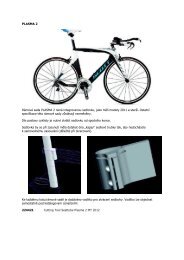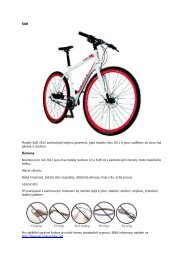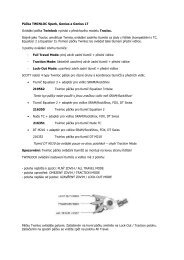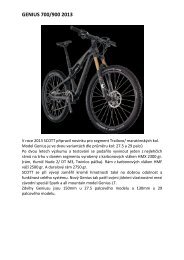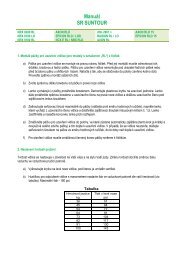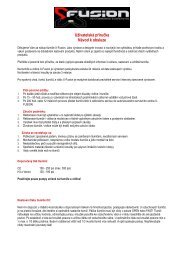NUdE2 rEAr ShOCk - Bicykle scott
NUdE2 rEAr ShOCk - Bicykle scott
NUdE2 rEAr ShOCk - Bicykle scott
Create successful ePaper yourself
Turn your PDF publications into a flip-book with our unique Google optimized e-Paper software.
A Comparison Of Wheel Sizes<br />
26" Wheel 27.5" Wheel 29" Wheel<br />
With three wheel sizes to choose from it’s best to find the size that suits your needs rather than getting<br />
hung up on a diameter. Once you’ve chosen the type of bike you want, look at the geometry to be sure<br />
the fit works for you while the travel suits your riding style. Bigger can be better, but only until the travel<br />
reaches a certain measure. See the research below.<br />
Improved roll-over effect is the most prolific attribute when it comes to 29” wheels. The big wheels are<br />
great for rolling over nasty roots and rocky sections, essentially making it easier to ride these conditions.<br />
Improved traction is also a key factor with the increased wheel diameter compared to 26” wheels as tire<br />
contact to the ground is larger.<br />
When discussing the pros and cons of the big wheeled bikes, shorter riders find themselves in an ambivalent<br />
situation. They want to benefit from the 29” wheels, but suffer from the negative effects when fit is<br />
considered. Additionally, the increase in rotational weight challenges many lower watt-producing riders,<br />
so the performance gains are negated when the rider cannot accelerate the wheel system as quickly.<br />
1. acceleration<br />
Diameter and rotating mass directly influence<br />
the acceleration of a wheel. The 29” wheel<br />
has both the largest diameter and the most<br />
rotating mass, and therefore takes the most<br />
energy and time to accelerate. The 26” wheel<br />
accelerates fastest, and the 27.5” wheel falls<br />
in between.<br />
4. weight<br />
The overall weight of the 27.5” wheel is only 5% (+ 140g ) more than a 26”<br />
wheel, compared to 11% (+ 430g) more weight for the 29” wheel. Calculation<br />
is made on the same type of wheels set front and rear, tires and inner tubes.<br />
Based weight for 26’’ is 2450g<br />
2. ANGLE OF ATTACK<br />
Increased wheel size decreases the angle<br />
of attack. That means bigger wheels make<br />
obstacles seem smaller.<br />
5. IMPROVED<br />
ROLL-OVER<br />
A larger wheel rolls over objects with greater ease due its increased diameter.<br />
The wheel literally spans a greater distance without being impeded. So you<br />
stay rolling over rough stuff and maintain your speed through the corners.<br />
+6°<br />
+3°<br />
3. momentum<br />
Larger wheels carry momentum better than<br />
smaller wheels. This means you continue to<br />
roll through technical sections without being<br />
hung up on objects and slowed down.<br />
6. MORE<br />
TRACTION<br />
The larger contact patch of a bigger wheel better connects the rider to the trail<br />
and provides improved traction over smaller wheels. This means more control<br />
and better braking.<br />
2013 BIKES 40 ACCESSORIES



